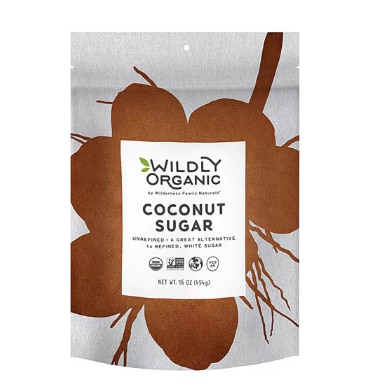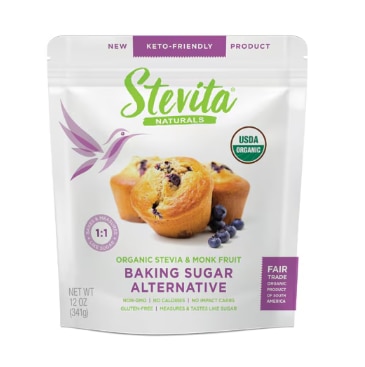Holiday cooking and baking are a joy. Part of the pleasure comes from seeing how much everyone enjoys eating your beautiful treats. Cookies, pies, pastries, marinades, stuffings, snacks or beverages are often special because they’re a little extra compared to our everyday fare. That’s what makes them fun for everyone. If you want to add another layer of goodness into your creations, using a variety of natural sweeteners can offer some new flavors and widen what some of your friends or family might be able to enjoy, no matter what their dietary needs are. It’s a great way to be inclusive and extend a lot of good cheer.
The Best Sugar Substitutes for Baking
Since sugar derived from sugarcane became the cheapest and most ubiquitous sweetener on the planet, it has found its way into just about everything from salad dressings to salt rubs. Every beverage, baked good or even potato chip you might find in the regular grocery store, will often just say sugar, sucanat, turbinado or brown sugar, which are all forms of highly processed cane. Stripped away from the fiber and nutrients, the juice is dehydrated into a crystal form that can be absorbed rapidly once it is on your tongue.
Alternative sweeteners are often absorbed more slowly and derived from sources like brown rice or the sap of trees or leaves. Here is a list of some common alternative sweeteners:
- Honey
- Agave syrup
- Maple sugar/syrup
- Coconut sugar
- Fruit juice concentrates
- Date sugar
- Brown rice syrup (or rice malt syrup)
- Allulose (a “rare sugar” that is generally low in calories and naturally occurs in some fruits)
- Monk fruit
- Stevia
Honey
Honey is not just for toast or salad dressing. With a wealth of health benefits, you can feel good putting a touch everywhere from meat or veggie dishes to baked goods. Almost everyone loves a salty sauce that has a touch of sweet to it, and honey has such a wide array of flavors to choose from. Remember to start slowly, using small amounts, when adding to a sauce or dressing because it can be very sweet and you can always add more if you want to. For cookies, crusts, cakes or pies, you can usually swap it 1 to 1 for a recipe’s amount of sugar and cut back on another liquid in the recipe to keep the right balance of wet to dry.
Agave syrup
Agave syrup (also called agave nectar) is the boiled down sap from the desert agave plant. Much like cane sugar, agave is highly processed, but it has some essential key differences from the white stuff. The first is that it is low on the glycemic index. That means it won’t raise your blood sugar drastically fast and cause an imbalance like white sugar, brown sugar or other cane sweeteners. Additionally, some claim the small amounts of vitamins in agave offer health benefits. The best reason to use it in your holiday baking is that it doesn’t impart a flavor of its own in your recipes. It’s great for salad dressings, frostings, puddings, ice creams and other dishes when you want the flavor to stay familiar. Use caution with baked goods because it can make some cookies or cakes have a different texture than desired.
Maple sugar/syrup
Maple sugar/syrup is a standard sweetener on pancakes, but it’s also wonderful for all types of sweet and savory dishes. Where many other alternative sweeteners can make your cookies soft, maple sugar in the granular form is the one that can make them crisp. When adding maple sugar to meringue cookies, sugar cookies or cakes, crisps or pies, they will be beautifully infused with maple’s unique sweetness. Maple sugar is even sweeter than white sugar, so you may want to use a little less. Maple can also make wonderful glazes. Often this requires reducing the syrup with an oil like butter to thicken it up. Maple can be especially wonderful during the holidays since its distinctive flavor shines through where ever you use it.
Coconut sugar
Coconut sugar (also called Palm Sugar) is one of the healthier sweeteners, and like the name implies, it comes from coconut palm trees. More specifically, the sap of the coconut palm tree blossoms. The sap is collected and then dehydrated, which is a lot of work, but well worth it. It will imbue caramel tones to your ice creams, cookies and other creations. Even if you use it in crystal form, baked goods made with coconut sugar can have a little extra moisture to them and be darker in color. Check for doneness that the brown tint doesn’t fool you as it can darken naturally and not be an indication of true browning. Coconut sugar dissolves easily in liquids and can be used 1-to-1 when substituting other sugars. It works especially well in recipes that call for “brown sugar” because it has a similar flavor profile.
Fruit juice concentrates
Fruit juice concentrates are fun to experiment with. Often sweeter than sugar, you can reduce the amount in a recipe, as well as reducing other liquid ingredients to accommodate. They are terrific for glazes, gels, frostings and cakes. In baked goods they will make things moist and sweet. Try them in a cranberry sauce, pumpkin pie filling or muffins in place of sugar. Reduce and dehydrate to make your own fruit leather.
Date sugar
Date sugar, date syrup or even fresh whole dates are all wonderful to add a rich sweetness to a recipe. Dates are the fruit of the date palm trees that grow in desert climates. Dates are low on the glycemic index and are full of beneficial nutrients, such as potassium, magnesium, iron and more. Granular date sugar is unique in that it is simply dates that have been ground up and dried. Nothing has been extracted so you get everything from the fiber to the nutrients. That also means it is a bit grittier than most sweeteners since the fiber won’t dissolve. Date syrup is less gritty but does retain some of the fiber. Fiber absorbs moisture. That means when using date sugar in baked goods, you can substitute it 1 to 1 for sugar but reduce the flour by about 1/4 cup to keep your recipe from being too dry. Date sugar is wonderful in sauces or crumbles, but not the best for beverages since it doesn’t dissolve the way other sweeteners will.
Brown rice syrup
Brown rice syrup is one of the gentlest sweeteners. It’s lower on the glycemic index than many others and has a lighter sweetness to it. Wonderful alone or mixed with stronger-flavored sweeteners like maple to tone down their flavor and add more of a caramel tone. Brown rice syrup is fructose-free and gluten-free, so it’s wonderful for those who are sensitive to other types of sweeteners. It’s made from slightly fermenting the rice with enzymes to break it down into a soup, then it gets cooked and strained into a thick sweet syrup. It does have a slight aftertaste if used in beverages or dressings, but it’s nice in baked goods and sauces. It holds up great for making brittle or other candies.
Allulose
Allulose has only recently become widely available. It’s a sweetener found naturally in things like raisins and figs, but unlike other sugars, your body doesn’t absorb it so it will not turn to fat and it does not raise blood sugar. Studies are sparse but allulose is reported to work well in baked goods. It is not as sweet as sugar so for frostings or cakes, you may want to increase the amount by 1/3 cup to have the same level of sweetness.
Monk fruit
Monk fruit is a real fruit that was really cultivated by monks in China. It has no calories and doesn’t raise blood sugar so it’s become a popular sweetener for beverages, sauces and treats. Structurally, monk fruit doesn’t offer the same reaction in baking that other sugars do, so it might not work for some cakes or cookies. It will work if you want to sweeten something up with a sprinkle on top. It’s not going to make your cereal mix or brittle stay together the way rice syrup will. Monk fruit is sweeter than sugar so you might want to cut down the amount by half when substituting it in a recipe.
Stevia
Stevia is also sweeter than sugar. It comes from the leaves of the stevia plant rather than a fruit and has no calories. Stevia does have a specific taste that you may or may not want in your creations. You only need about a teaspoon of liquid stevia to substitute in for a whole cup of sugar. This creates a problem for baking as you will need to add in something to replace the loss of moisture and volume. Both stevia powder and liquid dissolve easily and can be good in beverages, dressings or sauces. While some find stevia to have a chemical flavor, it’s actually a truly healthful sweetener with powerful antibacterial, antioxidant and many other benefits that have been widely studied.




